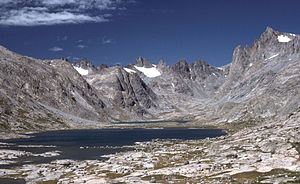Wind River Range



The Wind River Range (or "Winds" for short), is a mountain range of the Rocky Mountains in western Wyoming in the United States. The range runs roughly NW-SE for approximately 100 miles (161 km). The Continental Divide follows the crest of the range and includes Gannett Peak, which at 13,804 feet (4,207 m), is the highest peak in Wyoming. There are more than 40 other named peaks in excess of 13,000 feet (3,962 m).[1] Two large National Forests including three wilderness areas encompass most of the mountain range. Shoshone National Forest is on the eastern side of the continental divide while Bridger-Teton National Forest is on the west. Both National Forests and the entire mountain range are an integral part of the Greater Yellowstone Ecosystem. Portions of the range are also inside the Wind River Indian Reservation.
Geology
The Winds are composed primarily of a granitic batholith which is granite rock formed deep under the surface of the Earth, over one billion years ago. Over hundreds of millions of years, rocks that were once covering this batholith eroded away. As the land continued to rise during the Laramide orogeny, further erosion occurred until all that remained were the granitic rocks. The ice ages beginning 500,000 years ago began carving the rocks into their present shapes. Within the Winds, numerous lakes were formed by the glaciers and numerous cirques, or circular valleys, were carved out of the rocks, the most well known being the Cirque of the Towers, in the southern section of the range. Shoshone National Forest claims that there are 16 named and 140 unnamed glaciers just on the east side of the range for a total of 156, with another 27 reported by Bridger-Teton National Forest for the western slopes of the range. Several of these are the largest glaciers in the U.S. Rocky Mountains. Gannett Glacier which flows down the north slope of Gannett Peak, is the largest single glacier in the Rocky Mountains of the U.S., and is located in the Fitzpatrick Wilderness in Shoshone National Forest.
Hydrology
Several major rivers have headwaters on either side of the range. The Green and Big Sandy rivers drain southward from the west side of the range, while the Wind River drains eastward through the Shoshone Basin. The Green is the largest fork of the Colorado River while the Wind River, after changing its name to the Bighorn River, is the largest fork of the Yellowstone River
The Bridger Wilderness contains over 1,300 lakes. These lakes range in size from less than 3 acres (12,000 m2) to over 200 acres (0.81 km2), with an average size of about 10 acres (40,000 m2). Historically, the lakes and streams of the Bridger Wilderness were devoid of fish, as were most alpine lakes throughout the Rocky Mountains. The first known transplant of fish into the are took place in 1907 when Colorado cutthroat trout were introduced into North Fork Lake. Considerable fish stocking by individuals, the U.S. Forest Service, and the Wyoming Game & Fish Department, occurred between 1924 and 1935.[2]
Ecology
The Winds are known to have a small Grizzly Bear population, primarily in the northernmost areas. Other mammals include the black bear, elk, moose, mule deer, pronghorn, bighorn sheep, and wolverine. Bald eagles, falcons and hawks are just a few of the 300 species of birds known to inhabit the region. The streams and lakes are home to cutthroat trout, rainbow trout, brook trout, brown trout, Mackinaw Trout (Lake Trout), and Golden Trout — about 2.5 million of which were stocked by a local explorer named Finis Mitchell and his wife during the Great Depression. The forests are dominated by lodgepole pine, whitebark pine, subalpine fir, and Engelmann spruce.
The range sits alongside many of the animal migration routes in the United States and contains several important passes, notably South Pass, (7,412 ft / 2,301 m), at the south end of the range, which was one of the more important passes on the Oregon Trail as it passed through the Rockies. Aside from South Pass, which is at the southernmost tip of the range, no roads cross the mountains until Union Pass, (9,210 ft / 2,807 m) at the northern terminus of the range.
References
Cited references
- ^ "Wyoming 13,000-foot Peaks". Peakbagger. Retrieved 2007-04-06.
- ^ A Guide to Brider Wilderness Fishing Lakes. 1979, U.S. Department of Agriculture.
